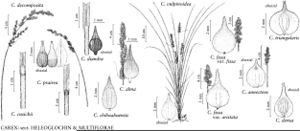Difference between revisions of "Carex annectens"
Bull. Torrey Bot. Club 35: 492. 1908.
FNA>Volume Importer |
FNA>Volume Importer |
||
| Line 11: | Line 11: | ||
|name=Carex xanthocarpa var. annectens | |name=Carex xanthocarpa var. annectens | ||
|authority=E. P. Bicknell | |authority=E. P. Bicknell | ||
| − | }}{{Treatment/ID/Synonym | + | }} {{Treatment/ID/Synonym |
|name=Carex bicknellii | |name=Carex bicknellii | ||
|authority=Dewey | |authority=Dewey | ||
| Line 18: | Line 18: | ||
|name=Carex annectens var. ambigua | |name=Carex annectens var. ambigua | ||
|authority=(Barratt ex Boott) Gleason | |authority=(Barratt ex Boott) Gleason | ||
| − | }}{{Treatment/ID/Synonym | + | }} {{Treatment/ID/Synonym |
|name=Carex annectens var. xanthcarpa | |name=Carex annectens var. xanthcarpa | ||
|authority=(Kükenthal) Wiegand | |authority=(Kükenthal) Wiegand | ||
| − | }}{{Treatment/ID/Synonym | + | }} {{Treatment/ID/Synonym |
|name=Carex brachyglossa | |name=Carex brachyglossa | ||
|authority=unknown | |authority=unknown | ||
| − | }}{{Treatment/ID/Synonym | + | }} {{Treatment/ID/Synonym |
|name=Carex setacea var. ambigua | |name=Carex setacea var. ambigua | ||
|authority=(Barratt ex Boott) Fernald | |authority=(Barratt ex Boott) Fernald | ||
| Line 42: | Line 42: | ||
|elevation=0–1500 m | |elevation=0–1500 m | ||
|distribution=Ont.;Que.;Ark.;Conn.;Del.;D.C.;Ill.;Ind.;Iowa;Kans.;Ky.;La.;Maine;Md.;Mass.;Mich.;Minn.;Miss.;Mo.;Nebr.;N.H.;N.J.;N.Y.;N.C.;Ohio;Okla.;Pa.;R.I.;S.C.;Tenn.;Vt.;Va.;W.Va.;Wis. | |distribution=Ont.;Que.;Ark.;Conn.;Del.;D.C.;Ill.;Ind.;Iowa;Kans.;Ky.;La.;Maine;Md.;Mass.;Mich.;Minn.;Miss.;Mo.;Nebr.;N.H.;N.J.;N.Y.;N.C.;Ohio;Okla.;Pa.;R.I.;S.C.;Tenn.;Vt.;Va.;W.Va.;Wis. | ||
| − | |discussion=<p>Carex annectens is similar in appearance to C. vulpinoidea, but can readily be distinguished by the flowering stems longer than the leaves and the orange-yellow perigynia that are usually ovate to suborbicular and short-beaked. Furthermore, that species is ecologically distinct and grows in open, dry to moist soils; C. vulpinoidea prefers wetter soils. It may be closely related to C. triangularis, which differs in having wider perigynia with red crystalline inclusions. Some authors recognize two taxa within the species (C. annectens var. annectans and var. xanthocarpa), distinguished by differences in perigynium color, inflorescence compactness, and pistillate scale awn length. All those characters appear to vary independently and within the same plant. Further detailed study may clarify patterns of biological variation within the taxon.</p> | + | |discussion=<p><i>Carex annectens</i> is similar in appearance to <i>C. vulpinoidea</i>, but can readily be distinguished by the flowering stems longer than the leaves and the orange-yellow perigynia that are usually ovate to suborbicular and short-beaked. Furthermore, that species is ecologically distinct and grows in open, dry to moist soils; <i>C. vulpinoidea</i> prefers wetter soils. It may be closely related to <i>C. triangularis</i>, which differs in having wider perigynia with red crystalline inclusions. Some authors recognize two taxa within the species (<i>C. annectens</i> var. annectans and var. xanthocarpa), distinguished by differences in perigynium color, inflorescence compactness, and pistillate scale awn length. All those characters appear to vary independently and within the same plant. Further detailed study may clarify patterns of biological variation within the taxon.</p> |
|tables= | |tables= | ||
|references={{Treatment/Reference | |references={{Treatment/Reference | ||
| Line 69: | Line 69: | ||
|publication year=1908 | |publication year=1908 | ||
|special status= | |special status= | ||
| − | |source xml=https://jpend@bitbucket.org/aafc-mbb/fna-data-curation.git/src/ | + | |source xml=https://jpend@bitbucket.org/aafc-mbb/fna-data-curation.git/src/8f726806613d60c220dc4493de13607dd3150896/coarse_grained_fna_xml/V23/V23_484.xml |
|genus=Carex | |genus=Carex | ||
|section=Carex sect. Multiflorae | |section=Carex sect. Multiflorae | ||
Revision as of 17:08, 18 September 2019
Culms to 75 cm × 2 mm, scabrous. Leaves: sheath fronts indistinctly spotted pale brown or red, apex convex, membranous, rugose; ligule rounded, to 3 mm, free limb to 0.2 mm; blades 60 cm × 5 mm, shorter than flowering stem. Inflorescences spicate, 4–7 cm × 15 mm, with 10–15 branches, proximal usually distinct; proximal internodes to 1.5 cm; bracts setaceous, proximal 1–3 conspicuous, distal bracts scalelike. Scales hyaline, red-brown with narrow colorless margins, awn to 1.5 mm. Perigynia golden brown, 3-veined abaxially, body broadly elliptic to ovate, 2.2–3 × 1.5–2.2 mm, base rounded; beak 0.5–1.2 mm, 1/3 length of body. Achenes red-brown, circular, 1.2–1.5 × 1–1.2 mm, glossy.
Phenology: Fruiting Jul–Aug.
Habitat: Dry to moist, often calcareous soils in open habitats, mesic to wet meadows
Elevation: 0–1500 m
Distribution

Ont., Que., Ark., Conn., Del., D.C., Ill., Ind., Iowa, Kans., Ky., La., Maine, Md., Mass., Mich., Minn., Miss., Mo., Nebr., N.H., N.J., N.Y., N.C., Ohio, Okla., Pa., R.I., S.C., Tenn., Vt., Va., W.Va., Wis.
Discussion
Carex annectens is similar in appearance to C. vulpinoidea, but can readily be distinguished by the flowering stems longer than the leaves and the orange-yellow perigynia that are usually ovate to suborbicular and short-beaked. Furthermore, that species is ecologically distinct and grows in open, dry to moist soils; C. vulpinoidea prefers wetter soils. It may be closely related to C. triangularis, which differs in having wider perigynia with red crystalline inclusions. Some authors recognize two taxa within the species (C. annectens var. annectans and var. xanthocarpa), distinguished by differences in perigynium color, inflorescence compactness, and pistillate scale awn length. All those characters appear to vary independently and within the same plant. Further detailed study may clarify patterns of biological variation within the taxon.
